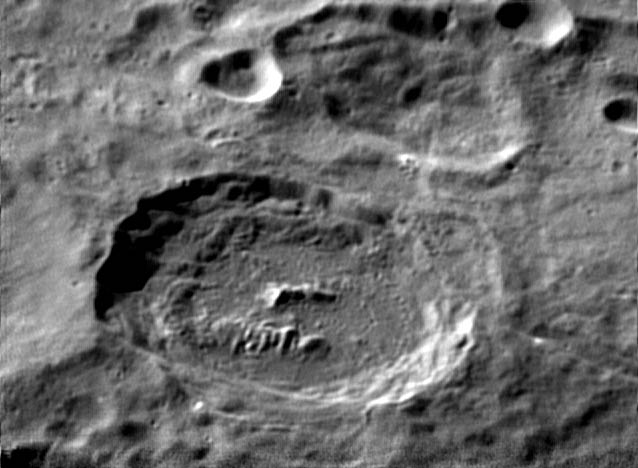Difference between revisions of "April 24, 2005"
| Line 3: | Line 3: | ||
<table width="85%" border="0" align="center" cellpadding="6" cellspacing="2"> | <table width="85%" border="0" align="center" cellpadding="6" cellspacing="2"> | ||
<tr> | <tr> | ||
| − | |||
</tr> | </tr> | ||
</table> | </table> | ||
| Line 20: | Line 19: | ||
<table class="story" border="0" bgcolor="#FFFFFF" width="90%" cellpadding="10" align="center"><tr><td> | <table class="story" border="0" bgcolor="#FFFFFF" width="90%" cellpadding="10" align="center"><tr><td> | ||
<p align="center"><b>Fabulous Fab!</b></p> | <p align="center"><b>Fabulous Fab!</b></p> | ||
| − | <p align="left">Have you ever looked carefully at Fabricius? I hadnt until I studied this great image. Usually Fabricius is seen as an obstruction hiding part of the floor of the large crater Janssen, but it is a fascinating crater in its own right. Fabricius (diameter 78 km) is mostly a Tycho-like complex crater, with terraced rim, flat floor and central peak. But the floor contains a horseshoe-like massive ridge. This is does not make Fabricius a [http://cwm.lpod.org/DataStuff/ffc.htm floor-fractured crater] - their concentric pattern is of rilles. I would guess that the floor arc of Fabricius formed by a terrace sliding down the crater walls. The ridge is completely free of the wall on the NW side, but is adjacent to the SE wall, like a normal terrace. On the southern portion of the floor a small crater occurs in the middle of a short rille, one of the few in a highlands crater. The rim of Fabricius has two abnormalities to notice. On the left (S), an angular scallop suggests that a large rim collapse started but | + | <p align="left">Have you ever looked carefully at Fabricius? I hadnt until I studied this great image. Usually Fabricius is seen as an obstruction hiding part of the floor of the large crater Janssen, but it is a fascinating crater in its own right. Fabricius (diameter 78 km) is mostly a Tycho-like complex crater, with terraced rim, flat floor and central peak. But the floor contains a horseshoe-like massive ridge. This is does not make Fabricius a [http://cwm.lpod.org/DataStuff/ffc.htm floor-fractured crater] - their concentric pattern is of rilles. I would guess that the floor arc of Fabricius formed by a terrace sliding down the crater walls. The ridge is completely free of the wall on the NW side, but is adjacent to the SE wall, like a normal terrace. On the southern portion of the floor a small crater occurs in the middle of a short rille, one of the few in a highlands crater. The rim of Fabricius has two abnormalities to notice. On the left (S), an angular scallop suggests that a large rim collapse started but didn't collapse entirely. At the bottom (W) of the crater a thin ridge extends from the rim onto the adjacent highland and then curves back. This looks like another place where a rim scallop subsided only slightly. Compare this image with the Lunar Orbiter IV image - they have essentially the same resolution!</p> |
| − | <blockquote><p align="right">— [mailto:tychocrater@yahoo.com Chuck Wood]</blockquote> | + | <blockquote> |
| − | <p align="left" | + | <p align="right">— [mailto:tychocrater@yahoo.com Chuck Wood]</blockquote> |
| + | <p align="left"><b>Technical Details:</b><br> | ||
April 15, 2005. 18" dob + Atik webcam + 5X's barlow + Baader IR passband filter.</p> | April 15, 2005. 18" dob + Atik webcam + 5X's barlow + Baader IR passband filter.</p> | ||
<p><b>Related Links:</b><br> | <p><b>Related Links:</b><br> | ||
Revision as of 17:20, 17 January 2015
Fabulous Fab!
Image Credit: Mike Wirths
|
|
Fabulous Fab! Have you ever looked carefully at Fabricius? I hadnt until I studied this great image. Usually Fabricius is seen as an obstruction hiding part of the floor of the large crater Janssen, but it is a fascinating crater in its own right. Fabricius (diameter 78 km) is mostly a Tycho-like complex crater, with terraced rim, flat floor and central peak. But the floor contains a horseshoe-like massive ridge. This is does not make Fabricius a floor-fractured crater - their concentric pattern is of rilles. I would guess that the floor arc of Fabricius formed by a terrace sliding down the crater walls. The ridge is completely free of the wall on the NW side, but is adjacent to the SE wall, like a normal terrace. On the southern portion of the floor a small crater occurs in the middle of a short rille, one of the few in a highlands crater. The rim of Fabricius has two abnormalities to notice. On the left (S), an angular scallop suggests that a large rim collapse started but didn't collapse entirely. At the bottom (W) of the crater a thin ridge extends from the rim onto the adjacent highland and then curves back. This looks like another place where a rim scallop subsided only slightly. Compare this image with the Lunar Orbiter IV image - they have essentially the same resolution! Technical Details: Related Links: Tomorrow's LPOD: A Chain of Mystery |
|
Author & Editor: Technical Consultant: Contact Translator: A service of: |
COMMENTS?
Register, and click on the Discussion tab at the top of the page.




